Bavaria - Oberaltaich church
| bottom |
Homepage Feedback? Enter your comments in the guest book |
Paris | |
| Previous | Back to Travelogue | Next |
7 of 15 |
|
Click on any picture to bring up the picture enlarged in a new window |
|||
| The confiscation of religious property following the Treaty of Westphalia (1648) The Peace of Westphalia had been for the benefit of Protestant princes only. More than a hundred monasteries and innumerable pious foundations disappeared at this time. Towards the middle of the eighteenth century a new movement tending to the destruction of monastic institutions swept over those portions of the German Empire which had remained attached to the Catholic Faith - particularly Bavaria. "Josephinism", as this political and religious movement was afterwards called, taking its name from its foster-father, the Holy Roman (Austrian) Emperor Joseph II (March 13, 1741 - 1790), made the Church subservient to the State. Emperor Joseph II was anxious to reduce the power of the church, wanted secularization of church lands, and wanted to reduce religious orders and the clergy in general to complete submission to the lay state. His his sister was Marie Antoinette, the queen of France who was beheaded during the French Revolution. |
| The supernatural character of the religious life was ignored; abbeys and convents could be permitted to exist only on giving proof of their material utility. A plan was formed at this period for the general secularization of monastic and other ecclesiastical property for the profit of the Catholic Governments in Germany. |
| The Elector Maximilian Joseph IV (King Maximilian I) of Bavaria completed the "Josephinism" work of destruction in Bavaria, A rescript of 9 September, 1800, deprived the religious orders in Bavaria of all property rights and prohibited them to receive novices. The convents of the mendicant orders (Franciscans, Dominicans, Augustinians, Carmelites) and the religious houses of women were the first to fall. Then came the turn of the Canons Regular and the Benedictines. The cathedral monasteries were not spared. Among the abbeys that disappeared in 1803 may be mentioned; St. Blasien of the Black Forest (the community, however, being admitted, in 1809, to the monastery of St. Paul), St. Emmeran of Ratisbon, Andechs, St. Ulrich of Augsburg, Michelsberg, Benedictbeurn, Ertal, Kempten, Metten, Oberaltaich, Ottobeurn, Scheyern, Tegernsee, Wessobrünn. |
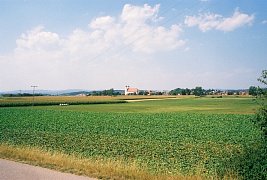
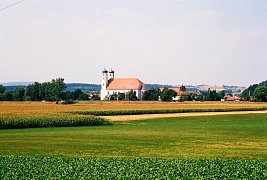 Here we are at Oberaltaich - the former monastery, founded around 1100 by the counts of Bogen. Our relative's farm was once part of the holdings
of this monastery but were taken away and sold. The monastery has changed very much over time,
a wall used to surround it and many buildings fell into ruin since the early 1800's. These
photos are taken from atop a dike near the Danube. Oberaltaich was built in the baroque style.
Here we are at Oberaltaich - the former monastery, founded around 1100 by the counts of Bogen. Our relative's farm was once part of the holdings
of this monastery but were taken away and sold. The monastery has changed very much over time,
a wall used to surround it and many buildings fell into ruin since the early 1800's. These
photos are taken from atop a dike near the Danube. Oberaltaich was built in the baroque style.
|
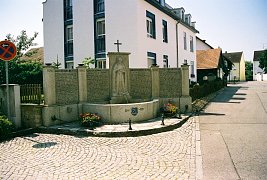
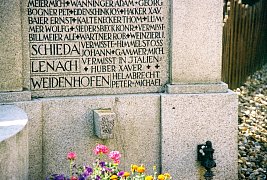 This is a memorial
to the young men of the area who died in WWII. Frieda's two uncles are listed here.
This is a memorial
to the young men of the area who died in WWII. Frieda's two uncles are listed here.
|
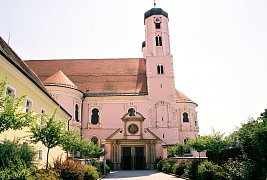
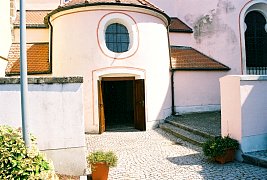 Here is the church. This little entrance off to the side is
the mortuary. Dead people are brought here
before burial. Frieda remembers that when she was young the coffins
was open and you could look at the dead people while praying for them.
Here is the church. This little entrance off to the side is
the mortuary. Dead people are brought here
before burial. Frieda remembers that when she was young the coffins
was open and you could look at the dead people while praying for them.
|
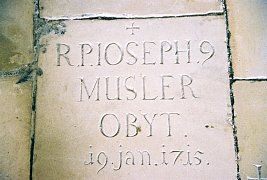
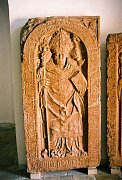 Many people are buried in the floor and walls of Oberaltaich. The rightmost picture
is a tombstone that used to stand outside - most likely a high ranking church official
from a long time ago. If you enlarge the picture you can see that
the headstone has been broken in two. I am guessing this was done by the
Swedes during the Thirty Year's War. The whole church was burned at that time.
Many people are buried in the floor and walls of Oberaltaich. The rightmost picture
is a tombstone that used to stand outside - most likely a high ranking church official
from a long time ago. If you enlarge the picture you can see that
the headstone has been broken in two. I am guessing this was done by the
Swedes during the Thirty Year's War. The whole church was burned at that time.
|
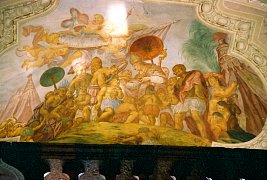
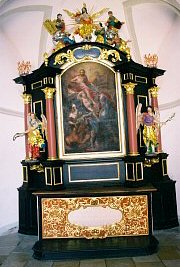
|
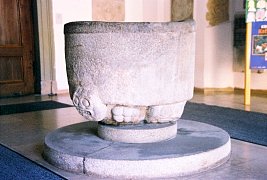 This baptism basin dates from about 1100 A.D.. It is Romanesque
style - look at the glowering face on the side.
Romanesque style features figures with mouths and eyes wide open. It was thought
these scary faces would scare away anything evil.
The Romans ruled this
area until around 400 A.D..
This basin is a leftover relic from a very old church which stood here
until it burned down in 1245.
This baptism basin dates from about 1100 A.D.. It is Romanesque
style - look at the glowering face on the side.
Romanesque style features figures with mouths and eyes wide open. It was thought
these scary faces would scare away anything evil.
The Romans ruled this
area until around 400 A.D..
This basin is a leftover relic from a very old church which stood here
until it burned down in 1245.
|
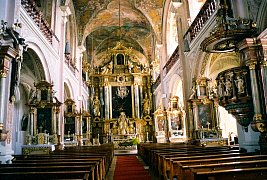
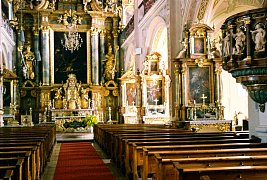 After the fire they built a new church, mostly in gothic style.
In 1543 they demolished this gothic
church and from 1622-1630 built a new church in special baroque style.
It was influenced by architects of the Italian Toscana. Three years later the new church
was destroyed by Swedish soldiers in the Thirty Year's War.
After the war they renovated the church. Some of the minor frescoes in the upper gallery show
an anti-Protestant bias. Protestant army leaders are depicted as fierce dogs, and behind the
organ Martin Luther can be seen riding on a wild boar.
After the fire they built a new church, mostly in gothic style.
In 1543 they demolished this gothic
church and from 1622-1630 built a new church in special baroque style.
It was influenced by architects of the Italian Toscana. Three years later the new church
was destroyed by Swedish soldiers in the Thirty Year's War.
After the war they renovated the church. Some of the minor frescoes in the upper gallery show
an anti-Protestant bias. Protestant army leaders are depicted as fierce dogs, and behind the
organ Martin Luther can be seen riding on a wild boar.
|
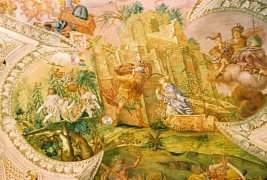
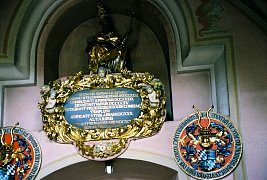
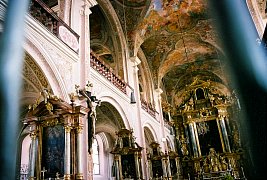
|
| The picture in the middle just above is found at the church entrance, is from 1693, and denotes that Oberaltaich church was founded in the year of 731 by duke Odilo, was consecrated by the holy Pirmin in 739, was burned by the Hunnen (Huns) in 904, and was rebuit in 1100 a.d. by earl Friedrich of Bogen. The religious figure above the writing is holy Peter, while at both sides are displayed the coat of arms of earls of Bogen. We attended mass here with our German family members on Sunday. Frieda and here father took us all through the church afterwards, including upstairs on the second floor. Later in the day we returned so I could take these pictures. A metal gate prevents entry into the church after services, so I had to shoot these pictures from outside the gate. A few of these pictures are out of focus, but I include them anyway to help give an idea of the beauty of this church. Enlarge the picture (above, center) and look at the ornate work - you see a knight's helmet and coats of arms. |
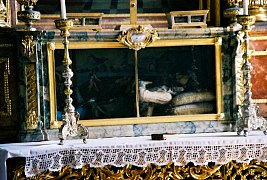
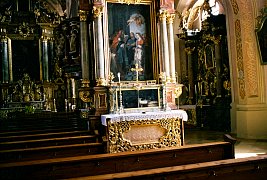 Do you notice all the altars throughout the church? Originally 24 of the
brothers at the monastery of Oberaltaich had an altar and each one would hold
his own Catholic mass. The destruction of the inside of the church by the
Swedes left only the 16 altars Of course there have been no Catholic
brothers here since the early 1800's. Inside most altars are what looks
like people in late 16th century dress.
Inside the boxes are small relics of holy people associated with each
alter, along with the doll people.
Do you notice all the altars throughout the church? Originally 24 of the
brothers at the monastery of Oberaltaich had an altar and each one would hold
his own Catholic mass. The destruction of the inside of the church by the
Swedes left only the 16 altars Of course there have been no Catholic
brothers here since the early 1800's. Inside most altars are what looks
like people in late 16th century dress.
Inside the boxes are small relics of holy people associated with each
alter, along with the doll people.
|
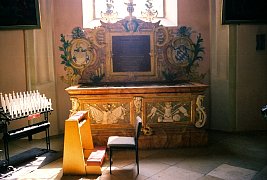
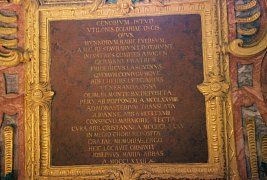 Here is shown in the picture with the chair before a huge tomb
the grave of the early benefactors of the monastery - the Counts of Bogen.
At both sides you can see the coat of arms of the Counts. In the right hand
side arms is the typical white and blue
diamond pattern, which you can also find in the Bavarian flag. Not
many people know
that this style of flag first belonged to the Counts of Bogen.
The carved words (in Latin and German) give the history of the monastery.
Bavarian Flag
I love Frieda's explanation of all the skulls and bones in the religious decor:
"Remember each day that you *too* shall die".
Here is shown in the picture with the chair before a huge tomb
the grave of the early benefactors of the monastery - the Counts of Bogen.
At both sides you can see the coat of arms of the Counts. In the right hand
side arms is the typical white and blue
diamond pattern, which you can also find in the Bavarian flag. Not
many people know
that this style of flag first belonged to the Counts of Bogen.
The carved words (in Latin and German) give the history of the monastery.
Bavarian Flag
I love Frieda's explanation of all the skulls and bones in the religious decor:
"Remember each day that you *too* shall die".
|
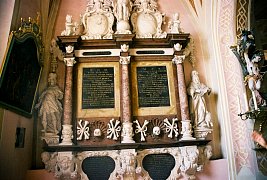
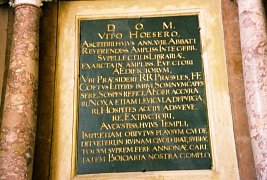
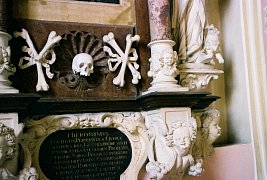 The grave of Veit-Hoeser - the abbot of the monastery who rebuilt monastery buildings and had the church reerected in 1634.
The grave of Veit-Hoeser - the abbot of the monastery who rebuilt monastery buildings and had the church reerected in 1634.
|
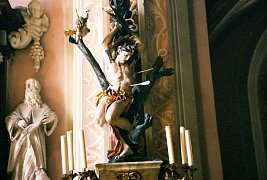 Look at the picture just above this and you will see St. Sebastian at the
right hand side.
The Acts, probably written at the beginning of the fifth century relate that Sebastian was an officer in the imperial bodyguard and had secretly done many
acts of love and charity for his brethren in the Faith. When he was finally discovered to be a Christian, in 286, he was
handed over to the Mauretanian archers, who pierced him with arrows; he was healed, however, by the widowed St.
Irene. He was finally killed by the blows of a club. The
earliest mosaic picture of St. Sebastian, which probably belongs to the year 682, shows a grown, bearded man in
court dress but contains no trace of an arrow. It was the art of the Renaissance that first portrayed him as a youth
pierced by arrows. In 367 a basilica which was one of the seven chief churches of Rome was built over his grave.
The present church was completed in 1611 by Scipio Cardinal Borghese. His relics in part were taken in the year
826 to St. Medard at Soissons. Sebastian is considered a protector against the plague. Celebrated answers to prayer
for his protection against the plague are related of Rome in 680, Milan in 1575, and Lisbon in 1599. His feast day is
20 January.
Look at the picture just above this and you will see St. Sebastian at the
right hand side.
The Acts, probably written at the beginning of the fifth century relate that Sebastian was an officer in the imperial bodyguard and had secretly done many
acts of love and charity for his brethren in the Faith. When he was finally discovered to be a Christian, in 286, he was
handed over to the Mauretanian archers, who pierced him with arrows; he was healed, however, by the widowed St.
Irene. He was finally killed by the blows of a club. The
earliest mosaic picture of St. Sebastian, which probably belongs to the year 682, shows a grown, bearded man in
court dress but contains no trace of an arrow. It was the art of the Renaissance that first portrayed him as a youth
pierced by arrows. In 367 a basilica which was one of the seven chief churches of Rome was built over his grave.
The present church was completed in 1611 by Scipio Cardinal Borghese. His relics in part were taken in the year
826 to St. Medard at Soissons. Sebastian is considered a protector against the plague. Celebrated answers to prayer
for his protection against the plague are related of Rome in 680, Milan in 1575, and Lisbon in 1599. His feast day is
20 January.
|
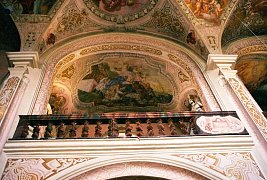
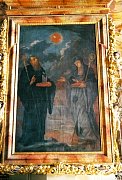
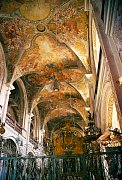 Here I think I was going for the artwork on display here in Oberaltaich - it's
hanging on the walls, it's in the floor, and it's painted on the ceiling. Most of
the ornate statues are actually made of wood and only one half of the statue
is really there - and that half is usually hollow. The Baroque style is all about show -
not about substance.
Here I think I was going for the artwork on display here in Oberaltaich - it's
hanging on the walls, it's in the floor, and it's painted on the ceiling. Most of
the ornate statues are actually made of wood and only one half of the statue
is really there - and that half is usually hollow. The Baroque style is all about show -
not about substance.
|
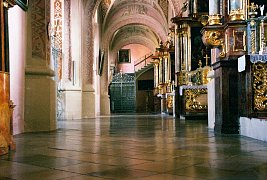 I know that if you visit Oberaltaich during the week you can request a guide
meet you and give you a tour. If you are very lucky, the guide will be a member
of my German family!
I know that if you visit Oberaltaich during the week you can request a guide
meet you and give you a tour. If you are very lucky, the guide will be a member
of my German family!
|
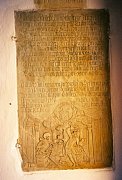 This gravestone in the wall really caught my eye. See the skeleton figure
interacting with the man wearing 17th century dress? Do you suppose the former
is telling the latter, "Remember each day that you too shall die"?
This gravestone in the wall really caught my eye. See the skeleton figure
interacting with the man wearing 17th century dress? Do you suppose the former
is telling the latter, "Remember each day that you too shall die"?
|
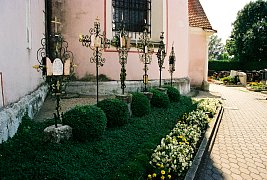 This is where priests and other religious men are buried. Frieda said her father
found bones sticking up out of the earth at the chapel at the farm. Most likely this
was from a graveyard which existed when the chapel was a church. Her father gathered
up the bones and had them buried here with the priests.
This is where priests and other religious men are buried. Frieda said her father
found bones sticking up out of the earth at the chapel at the farm. Most likely this
was from a graveyard which existed when the chapel was a church. Her father gathered
up the bones and had them buried here with the priests.
|
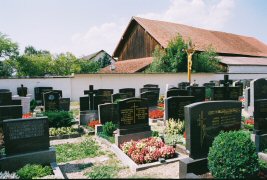
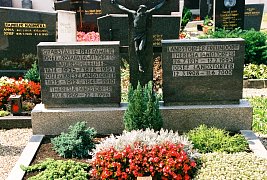 Our German relatives have burial plots outside the church. This family, 'Landsdorfer",
is the family of my grandfather's sister Rosalia. My grandfather faithfully kept
up correspondence with his
favorite sister back in Germany. While we were standing here pigeons passed over
and one got me in the shoulder. Subsequently I have heard that is supposed
to be good luck. Hopefully it does not indicate displeasure with me from beyond
the grave ... !
Our German relatives have burial plots outside the church. This family, 'Landsdorfer",
is the family of my grandfather's sister Rosalia. My grandfather faithfully kept
up correspondence with his
favorite sister back in Germany. While we were standing here pigeons passed over
and one got me in the shoulder. Subsequently I have heard that is supposed
to be good luck. Hopefully it does not indicate displeasure with me from beyond
the grave ... !
|
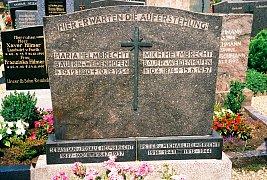 Here is the marker for our family. At the top is Frieda's grandparents - Michael
is the brother of my grandfather. At the bottom right are the names of Frieda's
uncles. Bottom left are Frieda and my great grandparents. "Bauer" means "farmer"
in English, "Bauerin" is "farm wife". Off to the left you see little candle
lanterns that are all over the graveyard. I bet it looks eery at night with all of
them lit. Notice the name "Hilmer" on the grave back and left? My grandfather
and a man from the farm down the road with the last name "Hilmer" left Germany
and came to America together.
Here is the marker for our family. At the top is Frieda's grandparents - Michael
is the brother of my grandfather. At the bottom right are the names of Frieda's
uncles. Bottom left are Frieda and my great grandparents. "Bauer" means "farmer"
in English, "Bauerin" is "farm wife". Off to the left you see little candle
lanterns that are all over the graveyard. I bet it looks eery at night with all of
them lit. Notice the name "Hilmer" on the grave back and left? My grandfather
and a man from the farm down the road with the last name "Hilmer" left Germany
and came to America together.
|
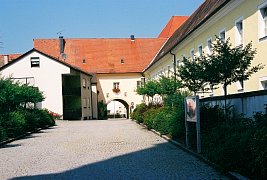
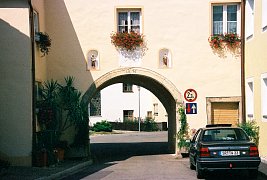 These final shots give you some idea of how the monastery used to look. It used
to be extensive. Quite a bit
of it fell into disrepair and fell down over the years, but some of it was
restored. I like the archway.
These final shots give you some idea of how the monastery used to look. It used
to be extensive. Quite a bit
of it fell into disrepair and fell down over the years, but some of it was
restored. I like the archway.
|
| top |
Homepage Feedback? Enter your comments in the guest book |
Paris | |
| Previous | Back to Travelogue | Next |
7 of 15 |
|
Click on any picture to bring up the picture enlarged in a new window |
|||